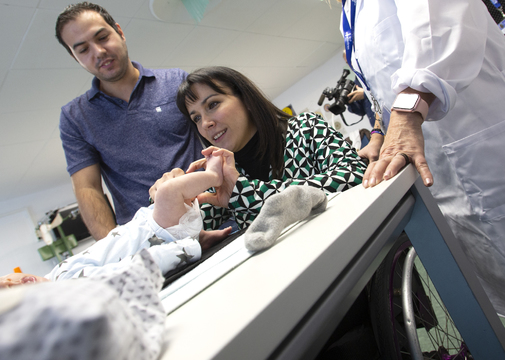- Video: So Jered walked again five years after becoming paraplegic
- Neurotechnology: The implant that has released three paraplegics from the wheelchair
Suffering a spinal cord injury means a lot of changes in the person's life and giving up many things. But one of these does not have to be having a child of its own. Although it is true that in some cases the conception can entail a greater difficulty and that both during pregnancy and after delivery there are some risks that increase, nothing prevents a spinal cord injured person from seeing his dream of being a father or mother fulfilled.
To help make this wish come true, the Hospital Valle de Hebron in Barcelona has launched a pioneering program through which, and through a multidisciplinary team, offer advice and follow-up to people with this physical disability who are willing to have children. " In some hospitals there were specific units that helped men to obtain semen or that could track pregnant women . But it is the first time that an integral group has been created that can offer all the help from a single center prior planning, pregnancy, childbirth and postpartum, "explains Karla Rojas, of the Medullary Injury Unit and the Pelvic Floor Unit of the Hebron Valley Hospital.
This was the case of Yasmina Andrés, one of the three women who have benefited this year from this program. "At 16, a traffic accident caused my spinal injury, but I was clear that I wanted to be a mother. Now at 33 I have been able to fulfill this dream and I am very happy," he explained in the presentation of the program.
Yasmina, who could have a spontaneous pregnancy without resorting to any fertilization technique, recognizes that, although her main concern was childbirth then the most complicated came later. "I was obsessed with that moment, knowing if I was going to get caught at home, if something was going to happen out of my control. But the pregnancy passed without major problems. Just a little more sweating and urine infections, but I did not have large complications. "
Problems in conception
In women there is initially a period of amenorrhea or absence of menstruation between six and twelve months after the injury, but between 50 and 90 percent later recover the monthly cycle and do not see their ability to become pregnant. "However, the decrease in sexual activity and the perception of difficulty in assuming a pregnancy makes the rates lower in these women than in those who do not have any injuries. We hope that with this program and the information we offer this can change "explained Julio Herrero, head of the Assisted Reproduction Unit.
The case of men is more conflictive, since these lesions can cause erectile dysfunction and difficulties in ejaculation autonomously. In addition, sperm quality can also be affected especially in the first ejaculations. " In this case, the treatment of choice consists in the stimulation of the glans with a vibrating device that helps the ejaculation to occur. Then we will see if the sperm are adequate or some other type of technique is necessary," said Karla Rojas.
When this stimulation does not work, there is a last resort for men that consists of open testicular biopsy. Thus the semen is extracted directly and the morphology and mobility of the sperm are checked. "Based on this, we decide whether to do insemination or opt for in vitro fertilization," added Herrero.
Caesarean section is not always necessary
Once the woman is pregnant, it is convenient to follow up that becomes more intense in the second and third trimesters. Patients with spinal injuries are more likely to present with pressure ulcers, thrombosis, urine infections or digestive disorders. It is also the time to perform a physical activity aimed at preventing neuropathic pain and preventing spasms from being triggered due to fetal movements, uterine contractions and changes in pharmacological treatment.
At the time of delivery, the most feared by these patients, it is possible that this occurs without the need for caesarean section. It was the case of Yasmina. " Although it was feared that I could have a premature delivery, in the end my child held on until the end and had to be induced at the end ." Anna Suy, chief of the Hebron Valley Obstetrics Section explained that this is done to avoid complications. "Caesarean section is not always necessary as is often thought, it is possible to do a vaginal delivery that is our first choice."
Breastfeeding can also be a problem. Many of the patients with spinal cord injury are polymedicated, so this should be taken into account. "Also the milk production is produced by a stimulation of the nipple with the sucking of the baby and there are women in whom the spinal cord injury can produce a numbness that hinders this process," Karla Rojas added. "In my case, because of my medication, I can only breastfeed the first three months," said Yasmina Andrés.
"In short, we want to convey the idea that a spinal cord injury is not an insurmountable obstacle to having a child, " explained Julio Herrero. "It is true that a whole multidisciplinary team is needed to follow up to overcome the complications that may arise, but all can be fathers and mothers. This idea is the one behind this program, with which we hope to become a reference in Spain".
According to the criteria of The Trust Project
Know more- Science and Health
- Health
Health The reality of viruses that promise to cure cancer
INTERVIEW "The goal is that there is no relapse in cancer"
ScienceThe incredible power of hormones: this way they alter your behavior without you knowing

